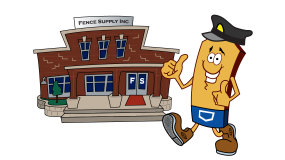Quality Items = Quality Fence
Choosing the right items for an electric fence could be a gruesome endeavor especially if these items are of the same use, with similarly sounding names, and most sellers of these products who only anticipate gain and somehow forget to explain slight differences in these items.
Take for instance in setting-up electric fence for animal enclosure, you will encounter MR. Poly Wire, Mr. Poly Rope, and Mr. Poly Tape. Never mind Mr. Steel and Mr. Aluminum since you are already long acquainted with them but, at least you should know the difference between the previous three Mr. Poly.
What would help you identify which item is which? The main difference between these three is their sizes and these are as follows:
Poly wire – This is he thinnest of the three poly items. Its diameter may range from 0.100” to 0.125”.
Poly rope – Thicker than the poly wire with diameter ranging from 0.125” to 1.000”.
Poly tape – This is the most visually identifiable from all three poly item since this is shaped like a tape unlike the first two which are rounded. Poly tapes width ranges from 0.500” to 2.500”
Now that you know these simple vocabularies, which type of wire should you choose? This depends on what type of enclosure you need and what type of animals you need to fence-in. Larger and stronger animals would need stronger wire with higher charge. Permanency of the fencing should also be taken into consideration in choosing the type of wire to use.
Below is a simple matrix that would help you decide:
|
Type |
Visibility |
Charge |
Durability |
Ideal Fencing Use |
| Poly wire | Acceptable | Low | Will not rust. | Temporary |
| Poly rope | Good | Average | Will not rust. | Temporary |
| Poly tape | Excellent | High | Will not rust. | Temporary/Semi-permanent |
| Steel wire | Poor | Very High | High tensile. | Semi-permanent/Permanent |
| Aluminum wire | Poor | Poor | May sag. | Permanent |
Another important item one needs to choose carefully for electric fencing needs are the posts he would use. There are various types of posts wood posts, rod posts, T-posts, fiberglass posts, step-in posts, pigtail posts and others.
Wood posts
Amongst all the available fences posts sold in the market, wood posts are the sturdiest of them all and the only one that would qualify as corner posts due to its resistance to strain. Due to their effective value these post may come in at a slightly higher price but they are worth every penny you put in buying them. Due to this, wood posts are seldom used as line post but they will properly serve this purpose and are most advisable if what you are planning to install is a permanent fence.
Aside from wood posts, there is no other type of fence post which is advisable for use as corner post due to the tension and stress carried by these areas. For line posts however, you may consider other types which are more customized for such use.
Steel rod posts
These are durable post which can be used as line posts particularly for temporary fences due to easy installation. This type of posts will not be able to carry too much strain so they are not recommended for corners.
Fiberglass rod posts
Fiberglass rods are similar to steel rod except for their composition. These posts which are lighter than steel rods are also recommended only for use as line posts of temporary fences.
These rod type posts would need clams for attaching the wire to them so you also need to consider this in choosing them.
Step-in posts
Step-in posts are the best type of post for use as line posts. These posts are made with large step-in flange for holding wires which makes it most recommended particularly when you will be using poly tape wires. Other features of this type of posts are its reinforced ribs, bottom spikes, and color. These features add strength, prevent rotation of the posts, and increase its visibility which makes it more appropriate for use.
Pigtail posts
A feature of this type of post which earned its name is the top loop which makes it look like a pig’s tail. Most recommended for cell grazing or Managed Intensive Rotational Grazing (MIRG) due to its portable use and ease of installation.
T-posts
These posts are more durable than step-in posts thus, are more recommended for use in permanent fences. These types of posts will last longer than other types due to its sturdy composition.
The wires and the posts are the most vital items for electric fencing. There are other items that you may need to acquire such as the fence chargers which are also vital items, anchors, fence insulators, and accessories.
Fence chargers also needs careful deliberation and will be discussed separately. Anchors, fence insulators, and accessories are items that you need to purchase according to your needs and are pretty much easier to choose.
The best thing that could help you in choosing the right items for your electric fence is to know what you need and which type of items would be suitable to be used as such. You should also keep in mind that quality does not necessarily mean expensive. There are affordable quality products you can find if you know where to look.



